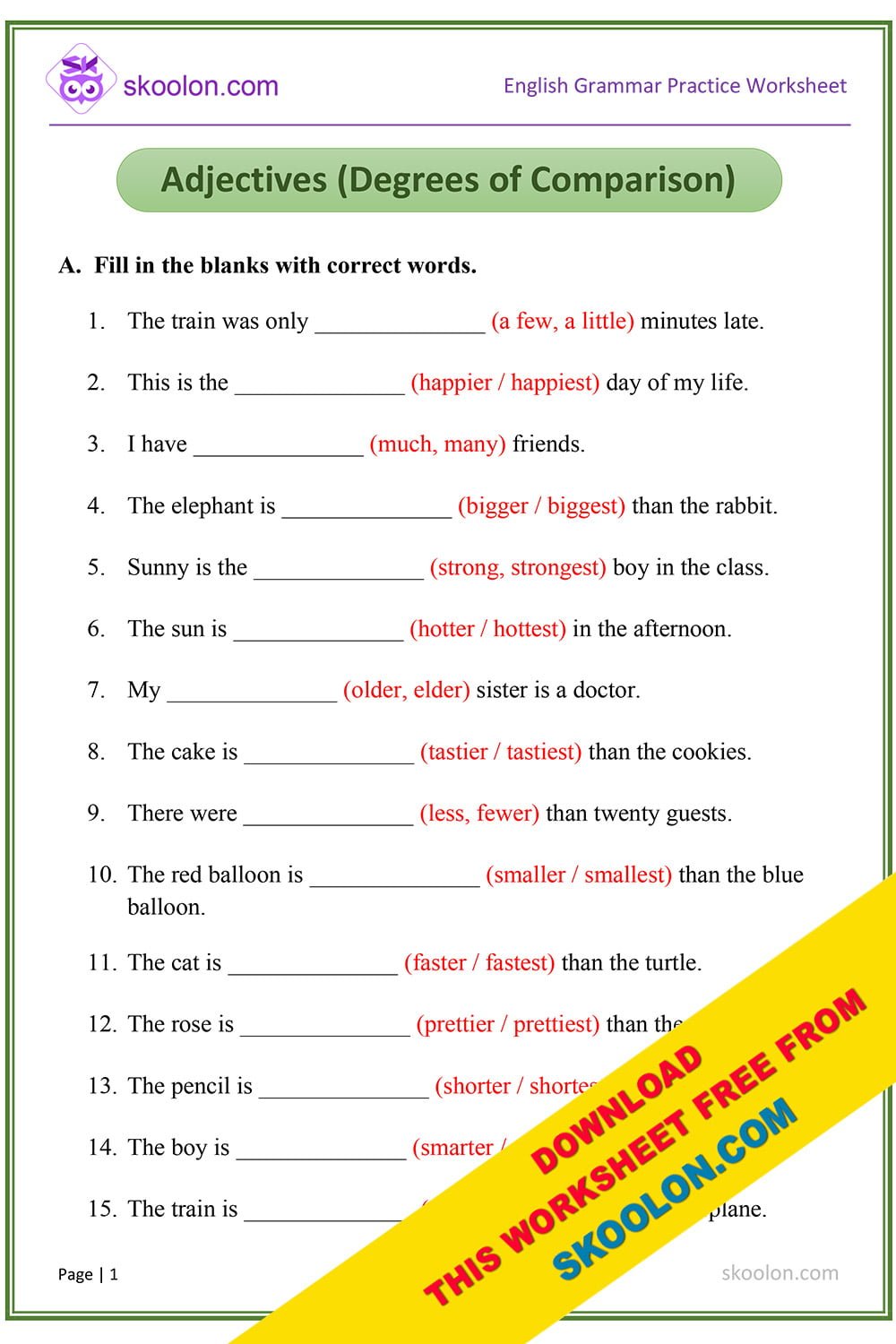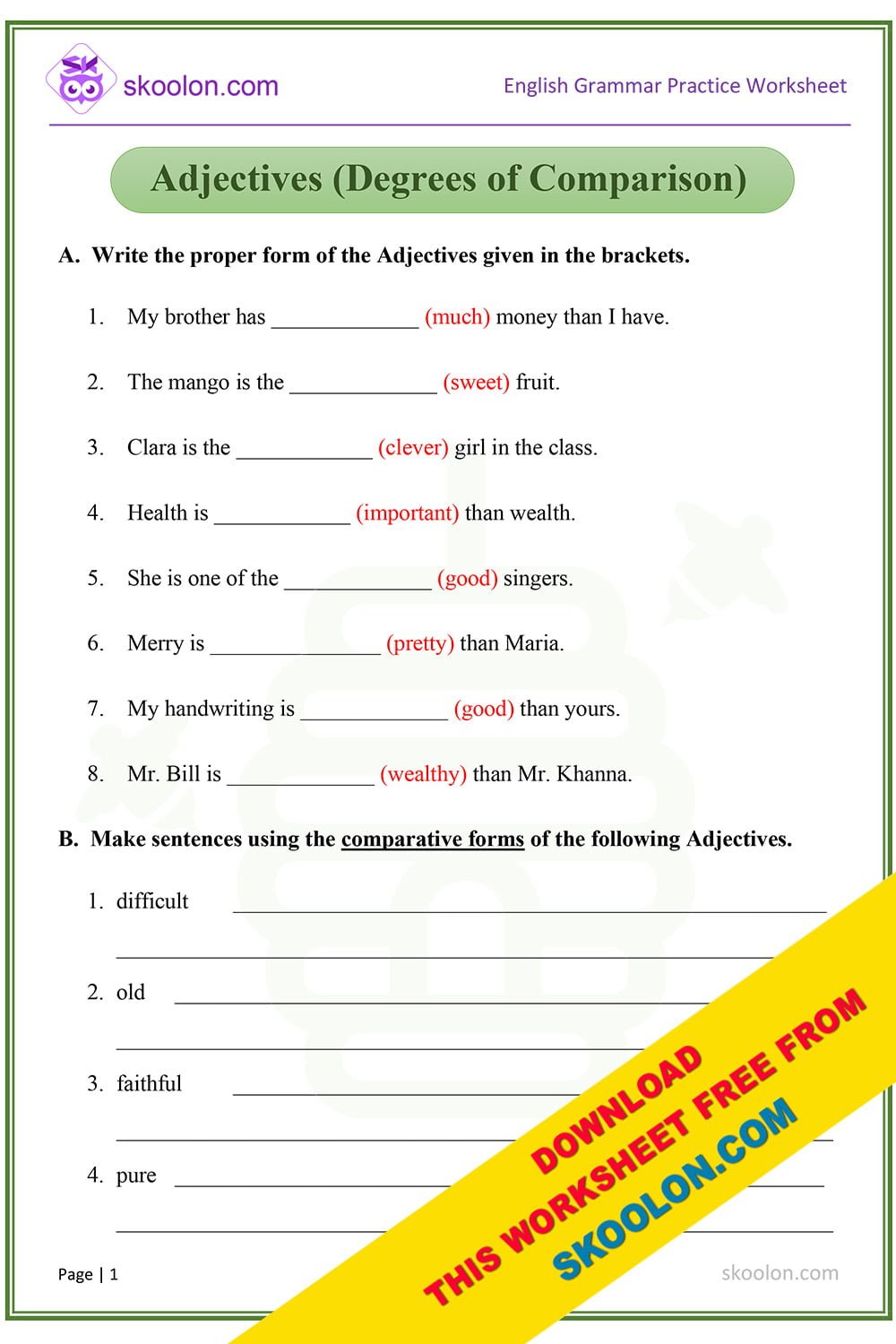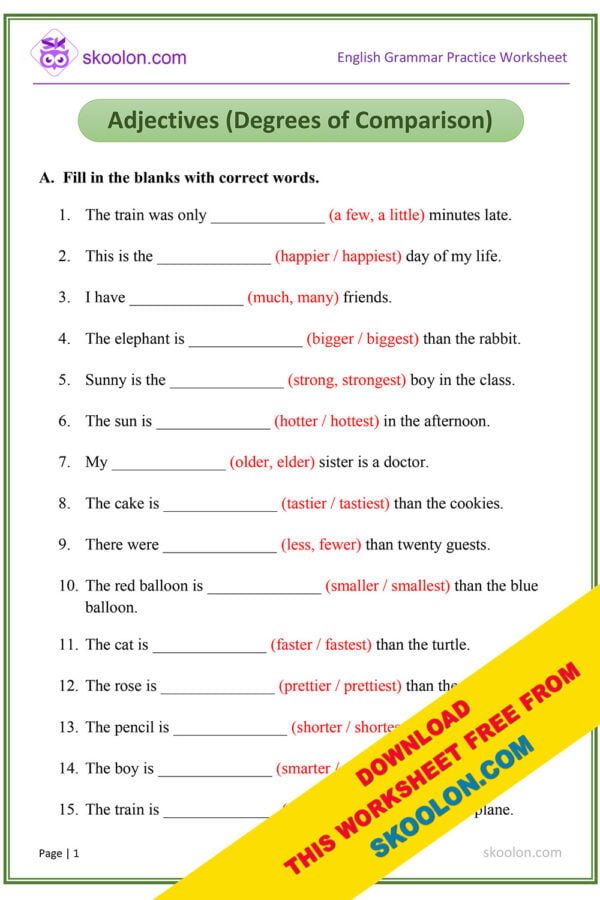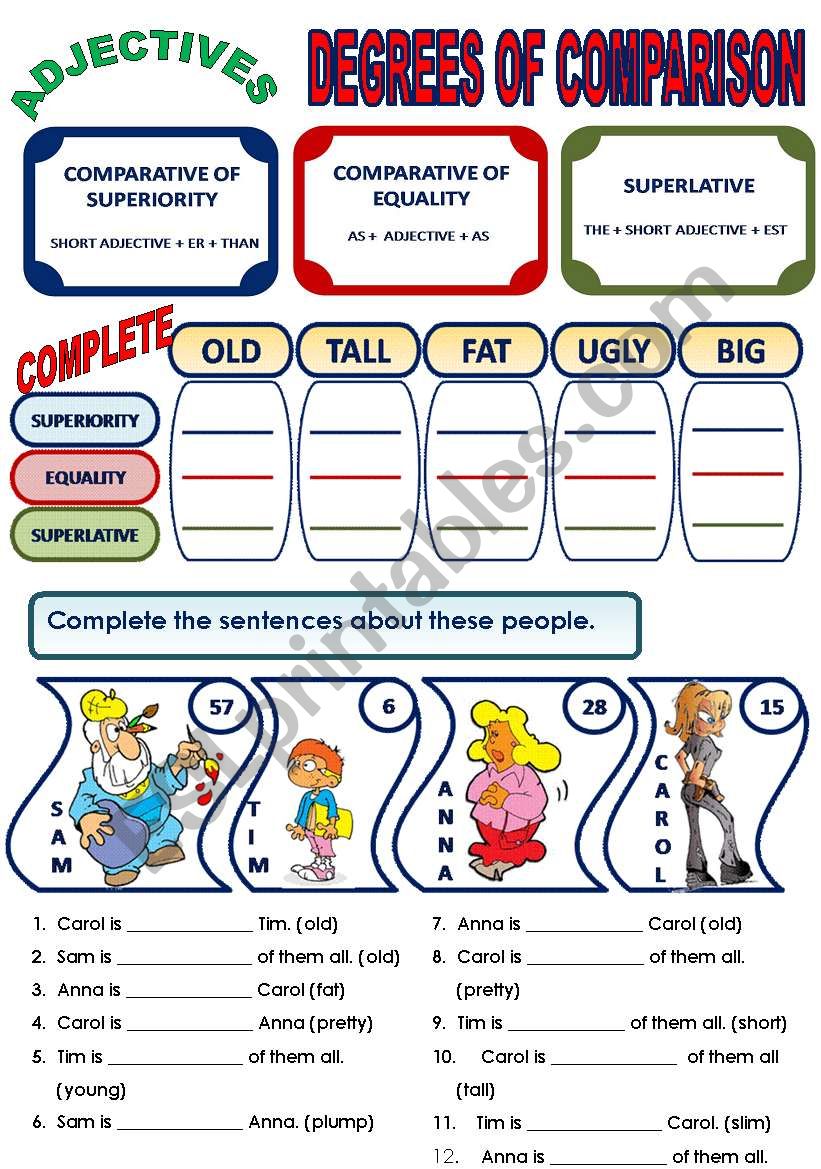
Mastering Adjective Degrees: The Indispensable Role of Degrees of Adjectives Exercises Worksheets
English, a language rich in nuance and description, owes much of its expressiveness to adjectives. These powerful words paint vivid pictures, convey precise information, and help us compare and contrast elements within our communication. However, simply knowing what an adjective is isn’t enough; true mastery comes from understanding their degrees – how they change form to show varying levels of quality or quantity. This is where degrees of adjectives exercises worksheets become an invaluable tool for learners and educators alike.
This comprehensive article will delve into the world of adjective degrees, explaining their fundamental concepts, outlining the different types of exercises found in effective worksheets, and providing guidance on how to best utilize these resources to achieve grammatical fluency.

Understanding Adjectives and Their Degrees

Before diving into the practical application, let’s firmly establish what adjectives are and how their degrees function.

What are Adjectives?

Adjectives are words that describe or modify nouns and pronouns. They provide more information about the person, place, thing, or idea they are referring to.

- Examples: tall building, beautiful flower, old book, happy child, blue sky.
The Three Degrees of Adjectives
Adjectives can change their form to show comparison. There are three main degrees:

-

The Positive Degree:
This is the basic form of the adjective, used when no comparison is being made. It simply describes a single noun or pronoun.
- Examples:

- She is a smart student.
- The car is fast.
- This is an interesting book.
- Examples:
-
The Comparative Degree:
This degree is used when comparing two nouns or pronouns. It indicates that one item possesses a quality to a greater or lesser extent than the other.- Formation Rules:
- For most one-syllable adjectives: Add "-er" to the end. (e.g., tall → taller, fast → faster, big → bigger – note the doubling of the consonant).
- For most two-syllable adjectives ending in -y: Change "y" to "i" and add "-er". (e.g., happy → happier, easy → easier).
- For most two-syllable adjectives not ending in -y, and all adjectives with three or more syllables: Use "more" before the adjective. (e.g., beautiful → more beautiful, intelligent → more intelligent, famous → more famous).
- Examples:
- She is smarter than her brother.
- The new car is faster than the old one.
- This book is more interesting than the last one I read.
- Formation Rules:
-
The Superlative Degree:
This degree is used when comparing three or more nouns or pronouns. It indicates that one item possesses a quality to the highest or lowest extent among the group. It is almost always preceded by "the."- Formation Rules:
- For most one-syllable adjectives: Add "-est" to the end. (e.g., tall → tallest, fast → fastest, big → biggest).
- For most two-syllable adjectives ending in -y: Change "y" to "i" and add "-est". (e.g., happy → happiest, easy → easiest).
- For most two-syllable adjectives not ending in -y, and all adjectives with three or more syllables: Use "most" before the adjective. (e.g., beautiful → most beautiful, intelligent → most intelligent, famous → most famous).
- Examples:
- She is the smartest student in the class.
- This is the fastest car on the road.
- This is the most interesting book I have ever read.
- Formation Rules:
Irregular Adjectives
No discussion of adjective degrees is complete without mentioning irregular adjectives. These adjectives do not follow the standard rules of adding "-er/-est" or "more/most." They have unique forms for their comparative and superlative degrees, which must be memorized.
Common irregular adjectives include:
- Good → Better → Best
- Bad → Worse → Worst
- Far → Farther/Further → Farthest/Furthest (Farther/Farthest for physical distance; Further/Furthest for metaphorical distance or additional quantity)
- Little → Less → Least (referring to quantity)
- Much/Many → More → Most (Much for uncountable nouns, Many for countable nouns)
Understanding these rules and exceptions is the bedrock upon which effective practice is built.
The Indispensable Role of Degrees of Adjectives Exercises Worksheets
Given the complexities of forming comparative and superlative adjectives, especially with irregular forms and syllable rules, consistent practice is not just beneficial—it’s essential. This is where degrees of adjectives exercises worksheets prove their worth. They provide a structured environment for learners to:
- Reinforce Rules: Repeatedly applying the rules for forming comparative and superlative degrees helps solidify them in the learner’s memory.
- Identify Weaknesses: Worksheets often highlight specific areas where a learner struggles, whether it’s distinguishing between "more" and "-er" or remembering irregular forms.
- Build Confidence: Successfully completing exercises builds confidence, encouraging learners to apply their knowledge in real-world communication.
- Provide Varied Practice: Good worksheets offer a range of exercise types, preventing monotony and engaging different learning styles.
- Offer Immediate Feedback: With answer keys, learners can immediately check their work, reinforcing correct answers and correcting mistakes.
Types of Exercises Found in Effective Degrees of Adjectives Exercises Worksheets
A well-designed worksheet isn’t just a list of words to transform. It incorporates a variety of exercise types to test understanding from multiple angles. Here are common and effective types:
-
Fill-in-the-Blanks (Simple Transformation):
- Description: Learners are given a sentence with a blank and an adjective in its positive form. They must fill the blank with the correct comparative or superlative form based on the context.
- Example:
- My dog is __ (big) than yours. (Answer: bigger)
- She is the __ (smart) student in the class. (Answer: smartest)
-
Sentence Transformation:
- Description: Learners are given a sentence and asked to rewrite it using a different degree of the adjective, often to compare different elements.
- Example:
- Rewrite using the comparative degree: "This book is interesting." → "This book is more interesting than that movie."
- Rewrite using the superlative degree: "He is a good runner." → "He is the best runner on the team."
-
Error Correction:
- Description: Learners are presented with sentences containing grammatical errors related to adjective degrees and must identify and correct them.
- Example:
- "This is the most happy day of my life." (Correction: "This is the happiest day of my life.")
- "My house is more bigger than yours." (Correction: "My house is bigger than yours.")
-
Matching Exercises:
- Description: Learners match positive adjectives with their corresponding comparative and superlative forms, often in a three-column format. This is particularly useful for memorizing irregular forms.
- Example:
- Good → Better → Best
- Bad → Worse → Worst
- Beautiful → More beautiful → Most beautiful
-
Creative Writing Prompts:
- Description: Learners are given a scenario or topic and asked to write sentences or a short paragraph, specifically incorporating adjectives in their comparative and superlative forms.
- Example: "Write a paragraph comparing three animals, describing their speed, size, and intelligence."
-
Comparative/Superlative Scenario Descriptions:
- Description: Learners are given pictures or descriptions of multiple items/people and asked to write sentences comparing them using appropriate adjective degrees.
- Example: (Picture of three different sized cars) "Car A is the smallest. Car B is bigger than Car A but smaller than Car C. Car C is the biggest."
-
Multiple Choice Questions:
- Description: Learners choose the correct adjective degree from a given set of options to complete a sentence.
- Example: "Of the two brothers, John is the ___. a) taller b) tallest c) most tall" (Answer: a) taller)
Designing and Utilizing Degrees of Adjectives Exercises Worksheets Effectively
Whether you are an educator creating your own materials or a learner seeking out resources, understanding what makes a worksheet effective is key.
For Educators/Worksheet Creators:
- Clarity and Simplicity: Instructions should be straightforward. Avoid overly complex sentence structures in the exercises themselves, especially for beginners.
- Progressive Difficulty: Start with simpler tasks (e.g., straightforward transformations) and gradually introduce more complex ones (e.g., error correction, creative writing) as the learner’s understanding grows.
- Variety is Key: As outlined above, incorporating different exercise types keeps learners engaged and tests different aspects of their knowledge.
- Include Irregular Adjectives: Make sure to dedicate significant portions of the worksheets to practicing irregular forms, as these are often the trickiest.
- Provide Answer Keys: This is crucial for self-assessment and allows learners to learn from their mistakes immediately.
- Contextualize: Where possible, use sentences that are meaningful and relatable to the learners’ experiences.
- Themed Worksheets: Consider creating worksheets around specific themes (e.g., comparing sports, describing holidays, ranking favorite foods) to make them more engaging. Finding high-quality degrees of adjectives exercises worksheets that incorporate these elements can significantly boost learning outcomes.
For Learners Utilizing Worksheets:
- Understand the Rules First: Before attempting exercises, ensure you have a solid grasp of the formation rules for positive, comparative, and superlative degrees, including irregular adjectives.
- Start with Simpler Exercises: Don’t jump straight into complex error correction if you’re still unsure about basic transformations. Build your foundation first.
- Pay Attention to Context: The context of a sentence (e.g., comparing two items vs. comparing many) will dictate which degree of adjective to use.
- Use the Answer Key Wisely: Don’t just copy answers. If you get something wrong, go back and understand why it was wrong. Refer back to the rules.
- Practice Regularly: Consistent, even short, practice sessions are more effective than infrequent, long ones.
- Don’t Be Afraid of Mistakes: Mistakes are opportunities to learn. Embrace them as part of the learning process.
Beyond the Worksheet: Integrating Practice
While degrees of adjectives exercises worksheets are fundamental, true mastery comes from integrating this grammatical knowledge into all aspects of language use.
- Reading: Pay attention to how adjectives are used in books, articles, and online content. Identify positive, comparative, and superlative forms.
- Listening: Notice how native speakers use these forms in conversations, movies, and podcasts.
- Speaking: Consciously try to incorporate comparative and superlative adjectives into your daily conversations. Describe things, compare options, and express preferences.
- Writing: Make a concerted effort to use a variety of adjective degrees in your essays, emails, and creative writing. This will make your writing more precise and engaging.
Conclusion
Adjectives are the descriptive backbone of the English language, and their degrees add layers of precision and expressiveness. From simple descriptions to complex comparisons, mastering positive, comparative, and superlative forms is crucial for effective communication. The dedicated practice provided by well-structured degrees of adjectives exercises worksheets offers an unparalleled pathway to achieving this mastery. By understanding the rules, engaging with diverse exercise types, and consistently applying this knowledge, learners can confidently wield adjectives to paint clearer, more vibrant pictures with their words. Embrace these valuable resources, and watch your grammatical fluency soar.
